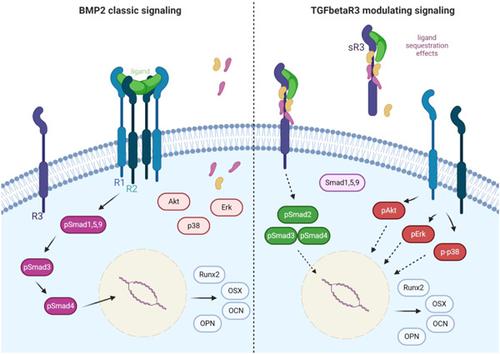当前位置:
X-MOL 学术
›
J. Cell. Biochem.
›
论文详情
Our official English website, www.x-mol.net, welcomes your
feedback! (Note: you will need to create a separate account there.)
Osteoinductive effect of soluble transforming growth factor beta receptor 3 on human osteoblast lineage
Journal of Cellular Biochemistry ( IF 3.0 ) Pub Date : 2021-01-22 , DOI: 10.1002/jcb.29888 Angelica Mastandrea Amanso 1 , Archana Kamalakar 1 , Sara Bitarafan 2 , Shelly Abramowicz 3 , Hicham Drissi 4, 5, 6 , Joey Victor Barnett 7 , Levi Benjamin Wood 2, 8 , S L Goudy 1
Journal of Cellular Biochemistry ( IF 3.0 ) Pub Date : 2021-01-22 , DOI: 10.1002/jcb.29888 Angelica Mastandrea Amanso 1 , Archana Kamalakar 1 , Sara Bitarafan 2 , Shelly Abramowicz 3 , Hicham Drissi 4, 5, 6 , Joey Victor Barnett 7 , Levi Benjamin Wood 2, 8 , S L Goudy 1
Affiliation

|
The development of bone requires carefully choregraphed signaling to bone progenitors to form bone. Our group recently described the requirement of transforming growth factor beta receptor 3 (TGFβR3), a receptor involved in TGFβ pathway signaling, during osteoblast lineage commitment in mice. The TGFβ pathway is known to play multiple osteo‐inductive and osteo‐inhibitory roles during osteoblast development and TGFβR3 human mutations are associated with reduced bone mineral density, making TGFβR3 a unique target for bone inductive therapy. In this article, we demonstrated increased mineralization of human pediatric bone‐derived osteoblast‐like cells (HBO) when treated with soluble TGFβR3 (sR3) using Alizarin Red staining. Osteogenic commitment of HBO cells was demonstrated by induction of osteogenic genes RUNX2, osteocalcin, osteopontin, and osterix. Evaluation of the canonical TGFβ pathway signaling demonstrated that sR3 was able to induce bone formation in HBO cells, mainly through activation of noncanonical targets of TGFβ pathway signaling including AKT, ERK, and p38 MAP kinases. Inhibition of these osteogenic noncanonical pathways in the HBO cells also inhibited mineralization, suggesting they are each required. Although no induction of SMAD1, 5, and 9 was observed, there was the activation of SMAD2 and 3 suggesting that sR3 is primarily signaling via the noncanonical pathways during osteogenic induction of the HBO. Our results highlight the important role of TGFβR3 in osteoblast induction of mineralization in human bone cells through noncanonical targets of TGFβ signaling. Future studies will focus on the ability of sR3 to induce bone regeneration in vivo using animal models.
中文翻译:

可溶性转化生长因子β受体3对人成骨细胞谱系的骨诱导作用
骨骼的发育需要精心设计的信号传导至骨骼祖细胞以形成骨骼。我们小组最近描述了在小鼠成骨细胞谱系定型过程中需要转化生长因子 β 受体 3 (TGFβR3),这是一种参与 TGFβ 通路信号传导的受体。已知 TGFβ 通路在成骨细胞发育过程中发挥多种骨诱导和骨抑制作用,TGFβR3 人类突变与骨矿物质密度降低有关,使 TGFβR3 成为骨诱导治疗的独特靶点。在本文中,我们证明了使用茜素红染色用可溶性 TGFβR3 (sR3) 处理时,人儿科骨源性成骨细胞样细胞 (HBO) 的矿化增加。HBO 细胞的成骨承诺通过诱导成骨基因 RUNX2、骨钙素、骨桥蛋白、和奥斯特里克斯。对经典 TGFβ 通路信号的评估表明,sR3 能够诱导 HBO 细胞中的骨形成,主要是通过激活 TGFβ 通路信号的非经典靶标,包括 AKT、ERK 和 p38 MAP 激酶。HBO 细胞中这些成骨非经典途径的抑制也抑制了矿化,表明它们都是必需的。虽然没有观察到 SMAD1、5 和 9 的诱导,但 SMAD2 和 3 的激活表明 sR3 在 HBO 的成骨诱导过程中主要通过非经典途径进行信号传导。我们的研究结果强调了 TGFβR3 在通过 TGFβ 信号传导的非经典靶点诱导人骨细胞矿化的成骨细胞中的重要作用。
更新日期:2021-03-31
中文翻译:

可溶性转化生长因子β受体3对人成骨细胞谱系的骨诱导作用
骨骼的发育需要精心设计的信号传导至骨骼祖细胞以形成骨骼。我们小组最近描述了在小鼠成骨细胞谱系定型过程中需要转化生长因子 β 受体 3 (TGFβR3),这是一种参与 TGFβ 通路信号传导的受体。已知 TGFβ 通路在成骨细胞发育过程中发挥多种骨诱导和骨抑制作用,TGFβR3 人类突变与骨矿物质密度降低有关,使 TGFβR3 成为骨诱导治疗的独特靶点。在本文中,我们证明了使用茜素红染色用可溶性 TGFβR3 (sR3) 处理时,人儿科骨源性成骨细胞样细胞 (HBO) 的矿化增加。HBO 细胞的成骨承诺通过诱导成骨基因 RUNX2、骨钙素、骨桥蛋白、和奥斯特里克斯。对经典 TGFβ 通路信号的评估表明,sR3 能够诱导 HBO 细胞中的骨形成,主要是通过激活 TGFβ 通路信号的非经典靶标,包括 AKT、ERK 和 p38 MAP 激酶。HBO 细胞中这些成骨非经典途径的抑制也抑制了矿化,表明它们都是必需的。虽然没有观察到 SMAD1、5 和 9 的诱导,但 SMAD2 和 3 的激活表明 sR3 在 HBO 的成骨诱导过程中主要通过非经典途径进行信号传导。我们的研究结果强调了 TGFβR3 在通过 TGFβ 信号传导的非经典靶点诱导人骨细胞矿化的成骨细胞中的重要作用。











































 京公网安备 11010802027423号
京公网安备 11010802027423号